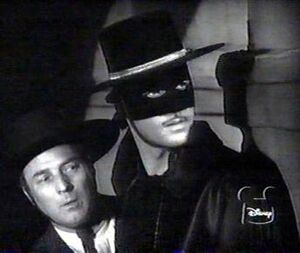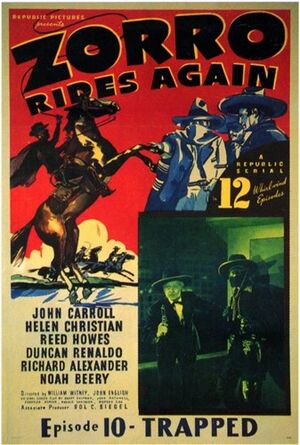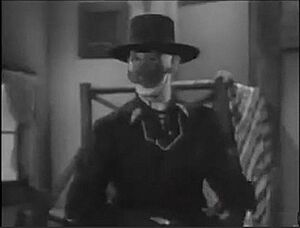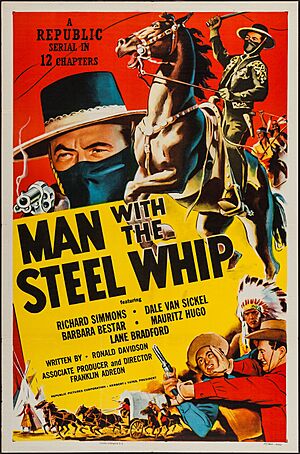Zorro facts for kids
Quick facts for kids Zorro |
|
|---|---|

The Cover to The Curse of Capistrano by Johnston McCulley, The All-Story Magazine, August 9, 1919, featuring the character
|
|
| First appearance | All-Story Weekly (August 1919) |
| Created by | Johnston McCulley |
| Portrayed by |
|
| Information | |
| Occupation | Nobleman, vigilante |
| Nationality | Californian (New Spain or Mexico) |
| Weapon | |
Zorro (which means "fox" in Spanish) is a famous fictional hero. He was created in 1919 by an American writer named Johnston McCulley. Zorro's stories are set in old California, specifically around the Pueblo of Los Angeles.
Zorro is usually shown as a brave, masked hero who fights for ordinary people. He protects them from mean and unfair officials and other bad guys. His special outfit is all black. It includes a cape, a hat called a sombrero cordobés, and a mask that covers the top part of his face.
In the stories, Zorro is very clever and hard to catch. The authorities try to get him, but he always outsmarts them. He even enjoys making them look silly in public! Because of his fox-like cleverness, people started calling him "El Zorro."
Zorro is also an amazing acrobat and skilled with many weapons. His favorite weapon is his rapier (a type of sword). He often uses it to carve a "Z" mark on his defeated enemies or other objects. This is his way of "signing his work." He is also a fantastic horse rider, and his loyal black horse is named Tornado.
Zorro's secret identity is Don Diego de la Vega. He is a young man from a wealthy family in California. Don Diego is the only son of Don Alejandro de la Vega, who owns a lot of land. Diego's mother has passed away. In most stories, Diego learned how to use a sword while studying in Spain. He became Zorro after his father called him home because California was being ruled by a harsh leader.
Don Diego usually lives with his father in a huge hacienda (a large estate). This hacienda has many secret passages and tunnels. These lead to a hidden cave that Zorro uses as his secret base. It's also where he hides Tornado. To keep his identity a secret, Diego pretends to be a bit of a coward and a fop (someone who cares too much about fashion). This way, no one suspects he is the brave Zorro.
Contents
Zorro's First Adventures
Zorro first appeared in a novel called The Curse of Capistrano in 1919. This story was originally meant to be a one-time adventure. But a movie based on the book, The Mark of Zorro (1920), became very popular. This movie starred Douglas Fairbanks and introduced Zorro's famous black costume. Because of the film's success, McCulley wrote many more Zorro stories for about 40 years.
In total, Zorro appeared in five serialized stories and 57 short stories. The last one was published in 1959, after McCulley had passed away. The Curse of Capistrano sold over 50 million copies, making it one of the best-selling books of all time. While most of McCulley's other Zorro stories weren't as famous, Zorro has appeared in over 40 films and ten TV series. The most well-known TV show was the Disney series Zorro (1957–1959), starring Guy Williams. Zorro has also appeared in other books, radio shows, comic books, plays, and video games.
Zorro was one of the first masked heroes with a secret identity. He inspired many similar characters in adventure stories and is seen as an early version of superheroes. Characters like Batman and the Lone Ranger have many similarities to Zorro.
Zorro's Story in Detail

In The Curse of Capistrano, Zorro became an outlaw in Los Angeles. He did this "to help the helpless, to punish cruel politicians, to aid the oppressed." People called him the "Curse of Capistrano." In this first story, the reader doesn't know that Don Diego Vega and Zorro are the same person until the very end.
In the story, Diego and Zorro are both interested in Lolita Pulido, a noblewoman who has lost her family's wealth. Lolita isn't impressed by Diego, who acts like he doesn't care about anything. But she is very attracted to the brave Zorro. The main bad guy is Captain Ramon, who also wants Lolita's attention.
Other characters include Sgt. Pedro Gonzales, who is Zorro's enemy but Diego's friend. There's also Bernardo, Diego's deaf and mute servant, and Fray (Friar) Felipe, who helps Zorro. Don Alejandro Vega, Diego's father, is the wealthiest landowner. Don Carlos Pulido and his wife, Doña Catalina, are Lolita's parents. At first, a group of noblemen hunts Zorro, but they eventually join his cause.
In later stories, McCulley added new characters like pirates and Native Americans. Some of these characters even knew Zorro's secret identity. McCulley sometimes changed details in his stories. For example, in the first story, Zorro's identity was revealed to everyone. But in later stories, it was still a secret.
Many Zorro movies and shows have added to his story. Some even show a younger character taking on the role of Zorro. McCulley's stories are set during the time when California was part of Spain (1769–1821). Some movies and TV shows place Zorro's adventures during the later time when California was part of Mexico (1821–1848).
Zorro's Look and Tools

Zorro usually wears a black costume. This includes a flowing Spanish cloak, a black flat-brimmed hat called a sombrero cordobés, and a black mask. The mask covers the top half of his face. Sometimes the mask is two pieces: a blindfold-like fabric for the eyes and a bandana for the head. This was seen in The Mark of Zorro (1920) and the Disney TV series. Other times, the mask is one piece that covers both. This was introduced in The Mark of Zorro (1940) and is common today. Sometimes, Zorro's mask is just a rounded domino mask. In his very first appearance, Zorro's cloak was purple, and his mask covered his whole face. Other parts of his costume can change.
His favorite weapon is a rapier, which is a thin, sharp sword. He uses it to leave his special "Z" mark. He also uses other weapons like a bullwhip and a pistol. The fox is not Zorro's symbol, but it represents his cleverness. The Disney TV show theme song even says, "Zorro, 'the Fox,' so cunning and free..."
Zorro's heroic pose often shows him rearing up on his horse, Tornado. He might salute with his hand or raise his sword high. The company that owns Zorro's rights uses an image of him on his horse with his sword raised as their logo.
Zorro's Amazing Abilities
Zorro is great at sneaking into enemy places and gathering secret information. He is also an expert with weapons and can escape from tricky situations. He's good at hiding and can understand many languages, which helps him talk to different people. Zorro is incredibly agile and can swing between rooftops using his bullwhip. He can also land safely from high places. He is a master swordsman and marksman, but he can also fight very well without weapons against many opponents.
In some stories, Zorro carries a small dagger hidden in his left boot for emergencies. He uses his cape in clever ways, like to block someone's view or to trip them. Sometimes, his boots and hat are weighted. He can even throw his hat like a Frisbee to warn enemies. He is also a smart planner, often teasing his opponents to make them fight poorly or fall into traps.
Zorro is an excellent horseman. His jet-black horse's name has changed over the years. In The Curse of Capistrano, the horse wasn't named. In Disney's Zorro TV series, the horse was named Tornado, and this name has been used in many stories since. In most versions, Zorro keeps Tornado in a secret cave. This cave is connected to his hacienda by secret passages.
McCulley's original stories sometimes showed Zorro being helped by a group of men. This isn't always part of other Zorro stories. One exception is Zorro's Fighting Legion (1939), where Zorro has masked helpers. In McCulley's stories, Zorro was helped by a deaf-mute servant named Bernardo. In Disney's Zorro TV series, Bernardo isn't deaf but pretends to be. He acts as Zorro's secret agent and is a very helpful friend. Sometimes, Bernardo even wears the Zorro mask to help keep Diego's secret safe.
The Family Channel's Zorro TV series replaced Bernardo with a teenager named Felipe, who also pretends to have a disability. In Isabel Allende's novel Zorro: A Novel, Bernardo is the son of the de la Vega family's Native housemaid. He and Diego are like brothers, as they were both nursed by Bernardo's mother. They are very close and travel together. After his mother is killed, Bernardo stops speaking. He later learns to speak again to his horse, Tornado, and to a Native girl he marries.
Diego's Personality
In The Curse of Capistrano, Diego is described as a "fair youth of excellent blood and twenty-four years." He was known for not caring much about important things. People thought he disliked action and rarely wore his sword, except for fashion. He was very polite to women but didn't show interest in any. He seemed to yawn a lot. This was all an act.
At the end of the novel, Diego explains his plan to have a double identity since he was fifteen: "It began ten years ago, when I was but a lad of fifteen," he said. "I heard tales of persecution. I saw my friends, the frailes, annoyed and robbed. I saw soldiers beat an old native who was my friend. And then I determined to play this game."
"It would be a difficult game to play, I knew. So I pretended to have small interest in life, so that men never would connect my name with that of the highwayman I expected to become. In secret, I practiced horsemanship and learned how to handle a blade—"
"By the saints, he did," Sergeant Gonzales growled.
"One half of me was the languid Don Diego you all knew, and the other half was the Curse of Capistrano I hoped one day to be. And then the time came, and my work began."
"It is a peculiar thing to explain, señores. The moment I donned cloak and mask, the Don Diego part of me fell away. My body straightened, new blood seemed to course through my veins, my voice grew strong and firm, fire came to me! And the moment I removed cloak and mask I was the languid Don Diego again. Is it not a peculiar thing?"
The 1920 film The Mark of Zorro changed this backstory a bit. In the movie, Diego returns from Spain at the start. Zorro later tells Lolita that he learned swordsmanship in Spain. The 1940 film The Mark of Zorro added that Diego was called home by his father because of a harsh dictator. Most Zorro stories since then have used these ideas.
Most Zorro stories follow McCulley's idea of Diego's personality. However, Disney's Zorro (1957–1959) is different. Diego still uses the fake personality at first, but he becomes a passionate fighter for justice. He pretends to be the "most inept swordsman in all of California." In this show, everyone knows Diego wants to be like Zorro but thinks he isn't skilled enough.
The Family Channel's Zorro (1990–1993) took this idea further. Diego pretends to be bad with a sword, but his fake personality also exaggerates his real interests. Diego loves art, poetry, books, and science. His act is to pretend he only cares about these things and not about sword fighting or action. In this version, Zorro also has a well-equipped lab in his secret cave.
In Isabel Allende's novel, Diego is a mestizo, meaning he has both Spanish and Native American heritage. His mother was a Shoshone warrior woman. This means Diego grew up balancing the noble ways of his father with the traditions of his Native mother and grandmother.
Who Inspired Zorro?
Many people believe Zorro was inspired by Joaquin Murrieta. He was a real person whose life was turned into a fictional story in 1854. In the 1998 film The Mask of Zorro, Murrieta's (fictional) brother, Alejandro, becomes the new Zorro after Diego.
Zorro is also similar to Sir Percival Blakeney, the hero of The Scarlet Pimpernel stories. Both are heroes with secret identities who tease their enemies by signing their deeds.
Other possible inspirations include Robin Hood, Reynard the Fox, and various historical figures from California and South America. Another idea is William Lamport, an Irish soldier who lived in Mexico in the 1600s. His life was written about in a book called The Irish Zorro.
The character of Spring-heeled Jack from old British stories might have also inspired Zorro. Spring-heeled Jack was a nobleman who created a flashy, masked alter ego to fight injustice. He was very athletic, good at fighting, had a hidden lair, and would carve the letter "S" with his sword.
Like Sir Percy in The Scarlet Pimpernel, Don Diego avoids suspicion by acting like a fancy, lazy person who loves poetry and avoids violence. Zorro's all-black costume, made famous by the Douglas Fairbanks film, might have been inspired by "The Masked Rider" from a 1919 film. This character was the first Mexican black-clad masked rider on a black horse in movies. Fairbanks's Zorro costume, released the next year, was very similar.
In 1860, a Hungarian writer named Mór Jókai wrote a novel about a Hungarian baron who had a secret identity as an outlaw. This character was inspired by a real baron who, according to local stories, had a similar secret life.
Zorro's Lasting Impact

Zorro has inspired many other characters. The 1936 film The Vigilantes Are Coming featured a masked hero similar to Zorro. Some countries even named the movie after Zorro. The main character, The Eagle, was played by Robert Livingston, who later played Zorro himself. This film was a new version of The Eagle, a silent film starring Rudolph Valentino. Valentino's character, the Black Eagle, was inspired by Douglas Fairbanks's Zorro.
The Masked Rider, the mascot of Texas Tech University, looks a lot like Zorro. It started as an unofficial mascot in 1936 and became the official one in 1954.
Zorro was one of the first fictional avengers with a secret identity. He inspired many similar characters and is seen as a forerunner to superheroes in American comic books. Jerry Siegel, who created Superman, said Zorro and The Scarlet Pimpernel inspired Superman's dual identity. Clark Kent's mild-mannered disguise was inspired by Don Diego de la Vega and Sir Percy Blakeney. Superman's early attitude as a "Champion of the Oppressed" was influenced by Douglas Fairbanks's adventure films like Robin Hood.
Bob Kane, who created Batman, also said Zorro was an inspiration. Like Don Diego de la Vega, Bruce Wayne (Batman's secret identity) is very rich. His everyday personality makes people think he is shallow and doesn't care much, which helps hide his secret. In some Batman stories, Bruce Wayne's parents are murdered after they leave a showing of the 1940 film The Mark of Zorro.
Zorro also inspired a similar character called El Coyote, created in 1943. A superhero character called The Fox in the Supers role-playing game is also based on Zorro.
The Republic Pictures serials Don Daredevil Rides Again (1951) and Man with the Steel Whip (1954) featured masked heroes similar to Zorro. Republic had made Zorro serials before but lost the rights. So, they created new heroes who looked like Zorro. These serials even used old footage from Zorro films, so the heroes' costumes sometimes changed between scenes!
The 1956 musical comedy The Court Jester has a masked freedom fighter called The Black Fox. He combines parts of both Zorro and Robin Hood.
Hanna-Barbera Productions made cartoons with Zorro-like characters. Pixie and Dixie and Mr. Jinks (1958–1961) had a character called "Mark of the Mouse." The Quick Draw McGraw Show (1959–1962) featured El Kabong, a Zorro-like alter ego of Quick Draw McGraw.
In the animated series Justice League (2001–2004), a DC Comics character named El Diablo looks very much like Zorro. He wears a similar hat, mask, sash, and cape. His main weapon is a whip.
In 2015, a Western Convention in Los Angeles had a special part about Zorro's history in movies and TV. It honored famous Zorro actors like Douglas Fairbanks and Guy Williams. There was even a live sword-fighting demonstration.
A cave used for filming in various Zorro productions is now known as "Zorro's Cave." It's hidden behind a building complex in Los Angeles, on land that was once a famous movie ranch.
The DreamWorks character Puss in Boots was also heavily inspired by Zorro. Puss in Boots is a cat who wears high boots, a wide-brimmed hat, and carries a rapier. He is voiced by Antonio Banderas, who also played Zorro in movies. Puss in Boots first appeared in Shrek 2 (2004) and has his own spin-off films.
Images for kids
See also
 In Spanish: El Zorro para niños
In Spanish: El Zorro para niños






